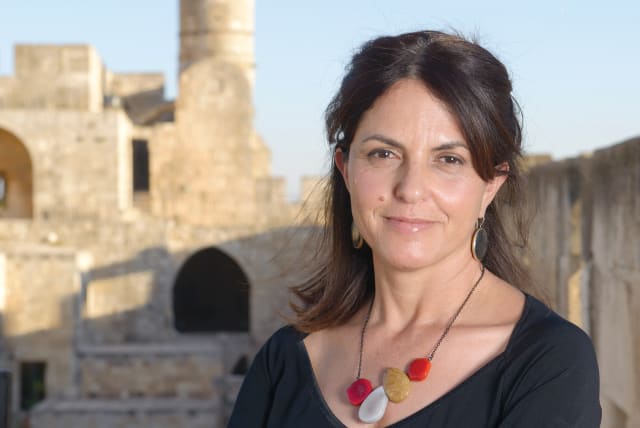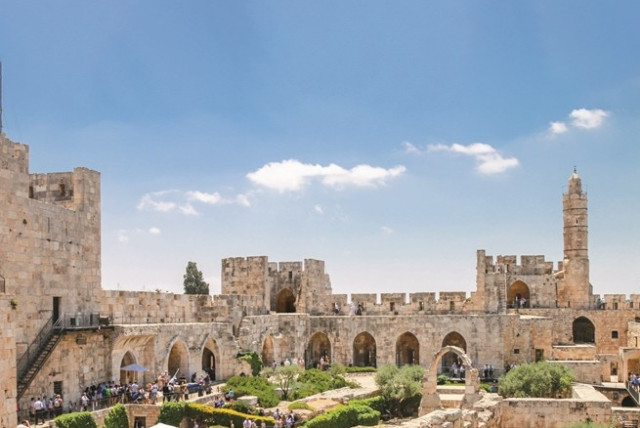Meet the creative force behind Jerusalem's Tower of David Museum

At the Table: Eilat Lieber has a gentle demeanor and sweet disposition – and she’s one of Jerusalem’s best self-proclaimed ambassadors.

At the Table: Eilat Lieber has a gentle demeanor and sweet disposition – and she’s one of Jerusalem’s best self-proclaimed ambassadors.
“Jerusalem is my inspiration,” Lieber says over sips of orange soup. Luciana’s, our dining spot on this frigid evening, offers a picturesque view of Jerusalem’s stone pathways, a mere hop, skip, and jump away from the Old City, where Lieber is director of the Tower of David (TOD).
The renovated Tower of David Museum will be debuting its first exhibition in the Angelina Drahi entrance pavilion on March 7, the day before the Jerusalem Marathon (in which Lieber will be running the 10K). Over the last decade, Lieber says she has been working to rebrand the TOD as “Jerusalem’s museum.”
“Jerusalem is a huge treasure trove of content,” she says. “We can do our exhibitions on food, music, fashion... now we have the infrastructure.”
Lieber is proud of her place of work. “Did you know that the first Israeli art museum was started at the TOD exactly 100 years ago?” she asks. “When the first British governor came to the city, he thought, ‘This must be a museum.’
“He recognized the beauty of the citadel and decided it shouldn’t be an army arch but a museum.”
Her Jerusalem story
Lieber has been working at the TOD since 2012. Hired to oversee the museum’s renovation, she came into her role not only with tremendous experience – she is the head of Jerusalem’s Culture Forum and member of the International Council of Museums – but also with a love and passion for the city.
She lives in Nataf in the Jerusalem Hills, not far from Mevaseret Zion. Her five children attended school in Jerusalem, and she has always worked here.
“I arrived in Jerusalem when I was 18,” Lieber says. “My name is Eilat because my parents met there – though I grew up in Beersheba!” At 18, she was sent to the capital for her army service, working with seven other young female soldiers at the Society for the Protection of Nature in Israel in the Russian Compound.
“I fell in love with Jerusalem then,” she recalls.
Completing her service, Lieber went on to study industrial design at Tel Aviv University, where she met her mentor, Prof. Mordechai Omer, her teacher and director of the Tel Aviv Museum of Art, which was undergoing its renovation at the time.
Omer inspired her to look for her own project, and she found it in the Shai Agnon House in Jerusalem’s Talpiot-Arnona neighborhood. The house belonged to the country’s only Hebrew writer who had won a Nobel Prize in Literature, but his home had been largely neglected.
“It was very sad to see, so I decided to try to change it.”
She went to the Culture Ministry for funds to make it happen, and they gave her NIS 300,000 – not nearly enough to even get started. But she was undeterred. She began holding activities around Agnon’s work and at the house. She created a buzz that led to successful fundraising and a stunning restoration project attracting visitors to this day.
“It was amazing to see that I could have this vision and take it from fantasy to reality,” she remarks.
So, when the job at TOD opened up, Lieber was a natural fit to direct the extensive renovation project in a place that had been operating successfully for three decades but was ready for a new set of eyes.
THE TOWER of David Jerusalem Museum reopened over the summer after 10 years of planning, three years of construction, and a $50 million investment.
The renovation includes preservation and restoration of the ancient structures, including the citadel, minaret, and archaeological garden; a new entrance pavilion; and 10 galleries incorporating technology, interactive displays, archaeological findings, and ancient artifacts.
“The TOD has to be awesome” to attract young people, Lieber says.
To engage the young generation, they focused on 21st-century language: technology, building an innovation lab, and working with start-ups to develop the visitor experience. “The TOD is the perfect meeting point between the Old City and the modern city of Jerusalem – and all of the communities that live here,” Lieber enthuses. “It’s a magical place.”
We try to steer Lieber more into her own story, but she cannot stop talking about the museum – a job that, in many ways, has become her life.
Until we ask about October 7.
TOD reopens on Oct. 8
Lieber recalls how when the sirens went off that morning, three of her sons started packing for the army instead of heading to synagogue. They are still fighting.
“I cannot sleep at night,” she admits. But she has a support network of friends in the same situation.
Earlier this month, when it became clear that 21 IDF soldiers fighting in Gaza had been killed when a building collapsed, she went into a panic until she knew that her son, there at the time, was safe. You can see tears in her eyes – not only for her children but for Israel’s children.
After a moment of silence, she turns back to the museum.
“We decided to open the museum the Sunday morning after the massacre,” Lieber says matter-of-factly. “I realized it was the best thing we could do.”
Tourists stranded in Israel visited the TOD in those first days. Then, they held programs for survivors from the South and North evacuated to Jerusalem.
She says the move was a “game changer” for the staff because “suddenly they had something significant to do – to be there for the people – to show them Jerusalem, to give them a break and some hope.
“When you touch Jerusalem’s history, you feel the meaning of what happened here. It’s a tough history but a place of hope.”
When Lieber married, she says her husband wanted to live in the Galilee, but she insisted against it.
“I belong here,” she tells us. “There is no city in the world like Jerusalem – the people, the colors, the meaning of what you see in its layers and layers of stories, culture, and art.
“Jerusalem is the heart of the Jewish people all over the world, and it is the reason we are fighting in the South.
“Jerusalem is how we know our enemies will not succeed.” ■
Jerusalem Post Store
`; document.getElementById("linkPremium").innerHTML = cont; var divWithLink = document.getElementById("premium-link"); if (divWithLink !== null && divWithLink !== 'undefined') { divWithLink.style.border = "solid 1px #cb0f3e"; divWithLink.style.textAlign = "center"; divWithLink.style.marginBottom = "15px"; divWithLink.style.marginTop = "15px"; divWithLink.style.width = "100%"; divWithLink.style.backgroundColor = "#122952"; divWithLink.style.color = "#ffffff"; divWithLink.style.lineHeight = "1.5"; } } (function (v, i) { });

